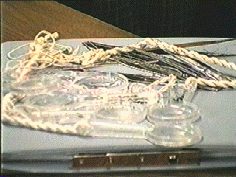Lesson Outline March 16, 1998
Table of Contents
- [Introduction]
- [Assignments]: Chapter 10-11
- [Materials and Ideas]:
- [Discussion of
Readings]: Chapter 10-11
- [Activity 1]: designing more water
activities
- [Activity 2]: vee mapping
- [Activity 3]: preparing images for
the web
- [Important links]
Introduction:
- Presenting your curriculum packages at the end of the course
(Mar 23, Mar 30). Who is presenting when?
- Course evaluations.
- Perry: submit your materials for the water unit.
- Water curriculum contributions
- Feb 2: Alisha [All the
Water in the World], Karin [Egg
float]
- Feb 9: Dawn and Polly [Acids
and bases]
- Feb 16: Michael, Rosy
[Erosion]
- Feb 23: Sean ["Cleaning
Water"], Tara [Watershed]
- Mar 2: Glenda [Safe water], Perry
[]
- MR: [Evaporation/
Condensation]
- [Temperature-dependence of Volume
of Water]
- Tara, Perry, Polly: [Concept map
1]
- Michael et al.: [Concept map 2]
- Water curriculum
([IRPs
Water Grade 4])
- MR: [Thermal expansion]
[top]
Assignments:
Assignment 1: Read Chapter 10-11 (Designing communities.
Participating is learning); send your comments and reaction to email
list.
[top]
Materials and Ideas:
- [Glenda's lesson]
[top]
Discussion: Readings:
- Open responses from ED-E445 students to
- Designing kowledge-building communities.
- Designing for designing, authentic problem solving.
- Discussion Designing:
- Why is it important to have a coherence of
activities rather than jumping back and forth between cute but
disconnected activities? (Which teachers sometimes do to "keep
children's interest") (GROUP: provide listing on newsprint
sheets)
- How do you balance the individual and social construction
of scientific knowledge and re-construction of canonical
scientific knowledge?.
[top]
Activity 1: Designing more
activities for the water curriculum
- As a class, design the concept map to be used with
our grade 4 water curriculum
- In groups of two, design one activity to be included in our
water curriculum to be added to the activities that we have so
far. Most importantly, include productive questions that can get
students and teacher to spin off into doing series of activities
beginning with your own.
[top]
Activity 2: Vee mapping:
Understanding helicopters (experiment)
Introduction. The epistemological vee as a scaffold for open
inquiry. Components of the vee.
As a class, find out as much as you can about the flight patterns
and flight characteristics of home-made helicopters. Report your
findings in vee-map format. Go through the following stages.
- Explore the helicopters
- As a class, identify individual research problems
- In each group, research a different question
- Conduct the experiment and report it in vee format
- Get together as a class, report your findings
- Make a summary statement about what you found out, future
questions to ask
[top]
Activity 3: Preparation of images
for web publication. Other computer applications.
- Claris Home page
- HTML pages and images; location of images.
- Size of image files, speed of loading, buttons
- Linking and link editor
- Image formats
- GIF and JPG/JPEG: <&emdash; TIFF, PICT, . . . .
.
- Graphic, paint programs and converters
- Copying from graphic program to converter
- Image sources
- Graphic programs (ADOBE Photoshop, ALDUS Freehand,
. . .)
- Scanners
- Video camera
- (Photo) Camera
Examples:

Figure 1: Shot with video camera and captured using Apple Video
Player.
Figure 2: To cut down on loading time, you can put your images on
a separate page, or leave them in GIF, JPG format. Index them to be
loaded when the user wants it. [Tools]
Computer applications: MathCAD.
Students' applications and webpages.
[top]
Important links:
[IRPs
Science K-7]
[Science Education
Associations]
[
AltaVista: Advanced Query] (Searching the net)
[top]